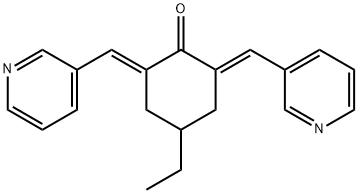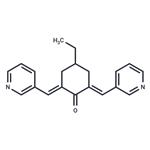MCB-613 is a stimulator of steroid receptor coativator (SRC).
ChEBI: MCB-613 is a cyclic ketone that is 4-ethylcyclohexanone which is substituted by pyridin-3-ylmethylene groups at positions 2 and 6. It is a potent small molecule stimulator of steroid receptor coactivators (SRCs). MCB-613 increases SRCs' interactions with other coactivators and markedly induces ER stress coupled to the generation of reactive oxygen species. Since cancer cells overexpress SRCs and rely on them for growth, MCB-613 can be used to selectively induce excessive stress in cancer cells. It has a role as a steroid receptor coactivator stimulator and an antineoplastic agent. It is a cyclic ketone, an enone and a member of pyridines.
mcb-613, 4-ethyl-2,6-bis-pyridin-3-ylmethylene-cyclohexanone, is a novel and potent stimulator of p160 steroid receptor coactivators (srcs). it is a pan-srcs stimulator. mcb-613 is confirmed to be a strong activator of all three srcs family proteins [1].members of the srcs family interact with nuclear receptors and other transcription factors to drive target gene expression while also functioning as integrators of upstream cell signaling pathways. three factors share homology with each other, they have distinct and important roles in multiple physiological processes, including growth and development, reproduction, and metabolism. all of them have been found to be broadly involved in different tumorigenesis. [2, 3]mcb-613 can super-activate transcriptional activity of srcs. mcb-613 markedly increases srcs’ interactions with other coactivators. coactivation of mmp2 or mmp13 promoter-driven luciferase reporter with src-3 was greatly enhanced by mcb-613. mcb-613 increased src-3’s interaction with cbp and carm1 robustly in a dose-dependent manner. [1]mcb-613 is cytotoxic. it can efficiently kill a variety of human cancer cell lines, including pc-3 (prostate), mcf-7 (breast), hepg2 (liver), and h1299 (lung)cells. cancer cells overexpress srcs and rely on them for cell growth, mcb-613 can selectively induce excessive er stress coupled to the generation of reactive oxygen species (ros) in cancer cells. [1]mcb-613 treatment probably leads to a distinct phosphorylation pattern on src-3, which will be interesting to pursue in future studies. [1]
wang l, yu y, chow dc et al. characterization of a steroid receptor coactivator small molecule stimulator that overstimulates cancer cells and leads to cell stress and death. cancer cell. 2015 aug 10;28(2):240-52. lonard, d. m., and o’malley, b.w. nuclear receptor coregulators: judges, juries, and executioners of cellular regulation. 2007. mol. cell 27, 691–700.anzick, s. l., kononen, j., walker, r.l.et al. aib1, a steroid receptor coactivator amplified in breast and ovarian cancer. 1997, science 277, 965–968.


